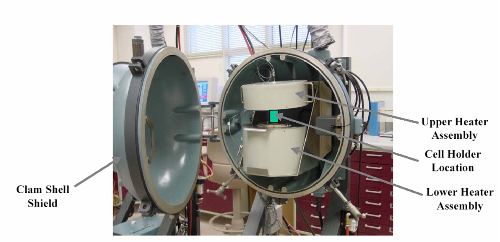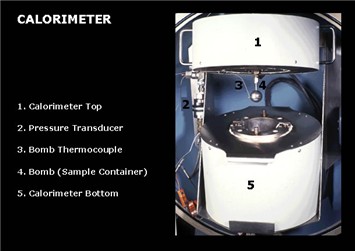ARC -
Accelerating Rate Calorimeter
Hazards
Laboratory
Michigan Tech University
Room 209 Chemical Sciences
ARC - Accelerating Rate Calorimeter Hazards
Laboratory
|
This
shows the outer "clam shell" of the ARC. The clam
shell provides containment. Also shown is the control unit on the table
and the instrumentation below the shell.
|
Purpose
The ARC is used to characterize the reactive nature of a chemicals. The substance is place in the small container (35 ml) shown below and then installed in the apparatus (also shown below). The ARC has two heating modes: (1) heat and search, and (2) heat.
In the heat and search mode, the substance is heated by fixed temperature increments, say 5 deg. C., and then the ARC waits at the specified temperature until an exotherm is detected. If an exotherm is detected, the ARC goes into adiabatic mode and follows the exotherm. If an exotherm is not detected, then the ARC moves to the next higher temperature.
In the heat mode, the temperature is increased continuously until an exotherm is detected, at which point the ARC goes into adiabatic mode and follows the exotherm.Data
The data from the ARC test includes the temperature and pressure as a function of time. These data can be used to calculate the following parameters used to characterize reactive chemicals:
- maximum self heat rate
- maximum pressure rate
- onset temperature
- reaction order and Arrhenius parameters
- others as required
Sensitivity
The ARC is capable of detecting self heat rates as low as 0.01 deg. C per minute and as high as 10 deg. C per minute. The major problem with the ARC is the high thermal inertia of the reactor vessel, which may produce misleading results under some conditions.
| These are the ARC bombs. The bomb on the right has been sawed open to show the insides and wall thickness. Bombs are available in a variety of materials. Bombs are available that can withstand pressures as high as 35,000 psi. A thermocouple clips on to the outside of the bomb to measure the temperature. |
| This shows the inside of the containment vessel. The bombs are heated by an upper and lower heater. The bomb is located at the colored spot. |  |
 |
This is a close-up view of the heaters and the location of the bomb. Notice the thermocouple clipped on to the side of the bomb. The pressure transducer is also shown. |